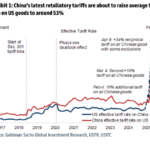Navigating the Turbulent Waters of Crude Oil Prices: Recent Trends and Influences
Tháng 4 4, 2025
Trump Extends TikTok Deadline: Impacts on U.S.-China Trade Relations
Tháng 4 4, 2025Major U.S. Stock Indices Plummet Amid Trade War Fears – Insights from April 4, 2025
On April 4, 2025, major U.S. stock indices experienced alarming declines, with closures between 5.5% and 6% as escalating concerns regarding a global trade war took center stage. This economic volatility was largely attributed to the recent tariffs imposed by President Donald Trump, which have triggered a sharp sell-off in both domestic and international markets. The market’s reaction signals significant anxiety among investors, reminiscent of tumultuous periods like the one faced during the COVID-19 pandemic, where recognizing market emotional swings and avoiding key investment mistakes would have been crucial. For a deeper understanding of how to navigate such market challenges, you can read about the top investment mistakes to avoid in 2023 here.
Key Market Movements
The NASDAQ composite index was particularly hard-hit, plummeting by 6%, primarily reflecting the tech sector’s ongoing vulnerabilities. The decline underscores the sensitivity of technology stocks to global economic indicators. Similarly, the S&P 500 fell approximately 4.8%, while the Dow Jones Industrial Average also reflected substantial losses, nearing the 4% mark. This decline marks a critical moment, being the worst performance for these indices since June 2020, illustrating just how quickly market sentiment can shift under pressure.
Impact on Major Companies
The downturn significantly impacted several major companies. Nike, for instance, faced a staggering 14% drop in share value, indicating heightened sensitivities within retail environments reliant on both domestic revenue and international supply chains. Technology giants such as Apple and Amazon were not immune either, recording declines of around 9% each.
The so-called “Magnificent Seven,” a group of influential tech firms, also fell victim to the market downturn. Meta, the parent company of Facebook, saw losses close to 9%, while Nvidia dropped by 7%, showcasing the widespread implications of trade uncertainty across diverse sectors. The retail sector, especially businesses reliant on imported goods, experienced severe repercussions, with Dollar Tree shares plunging by 13% and Five Below suffering an astonishing 27% decrease.
Global Market Reactions
The ramifications of Trump’s tariffs did not confine themselves to U.S. borders; global markets reacted swiftly, further compounding investor concerns. In Japan, the Nikkei 225 index declined by 3.5%, while the Topix index dropped by 4.45%. South Korea’s KOSPI index recorded a decrease of 1.7%, and both India’s Nifty 50 and BSE Sensex indices fell by over 1%. These results highlight the interconnected nature of global markets, where economic policies in one nation can swiftly reverberate through others. Insights on China’s strategic moves amid global trade tensions may provide a broader perspective on these shifts, which can be explored here.
As trading resumed on Friday, futures for the NASDAQ, S&P 500, and Dow Jones indicated potential further declines of approximately 0.3%. This overall bearish trend not only reflects the ongoing economic challenges but also fuels investor anxiety regarding the effectiveness of strategies to mitigate risks associated with rising protectionism and trade disputes.
In conclusion, the steep declines witnessed across major U.S. stock indices on April 4, 2025, serve as a wakeup call. Investors and market analysts will need to closely monitor developments in trade relations, as the outcomes will undoubtedly shape economic forecasts and strategies in the months to come. For further insights into investment strategies that adapt to market volatility, consider the principles of value investing discussed here. The current landscape demands a strategic approach to navigate the turbulent waters ahead.

